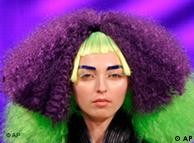From the Fringe | 01.09.2008
Bad Hair Today May Be Gone Tomorrow
Struggling with split ends? Nagged by knots? Troubled by tangles? Thanks to some German chemists working in the new field of haptics, those bad-hair days may be a thing of the past.
Unless you are bald or nearly so, you have probably had a morning like this at least once.
The clock is ticking as you hurry to get ready to go outside. But wait -- the comb gets tangled in your unruly mane, which refuses to lie flat. Or conversely, your hopes for a full-bodied style are foiled when your locks refuse to be styled, and stay plastered to your head in lank strands instead.
Hair products, styling wands, straightening irons -- you pull out the whole arsenal, to no avail. Frustration builds, the mood goes sour. Eventually, you give up. You pull out a scarf, or a cap, or both.
Or maybe you just stay at home. Move over, Amy Winehouse. You're having a bad hair day.
 Bildunterschrift: Großansicht des Bildes mit der Bildunterschrift: Amy Winehouse: proactive on bad hair
Bildunterschrift: Großansicht des Bildes mit der Bildunterschrift: Amy Winehouse: proactive on bad hair
Now, a pair of fearless German research chemists have taken it upon themselves to save people, if not from a fate worse than death, then at least from the occasional ruined morning.
New scientific methods
Using methods from the relatively new science of haptics -- that is, how the subjective perception of touch connects to objective surface properties of hair and other materials --.they have developed the first detailed microscopic analysis of what happens to individual hair fibers when they get tangled up and won't let go.
The chemists from the University of Bayreuth claim their research could pave the way to the development of improved shampoos, conditioners and other products for repairing damaged hair, according to the findings which were presented at the American Chemical Society's 236th ACS National Meeting in Philadelphia.
In the new study, the researchers invented a unique technology for analyzing hair that involves mounting individual hair fibers on a cantilevered tip of an atomic-force microscope and measuring their interactions as they touch each other.
Two reasons for bad hair
"The system will allow scientists to explore how different hair-care products affect hair-to-hair interactions so that these products can be optimized in a more systematic fashion," says study co-author Eva Max, a doctoral student in chemistry at the University of Bayreuth in Germany.
Max said her findings showed that hair feels rough and difficult to comb for two main reasons. On the one hand, mechanical damage to a hair's surface creates scaly projections that jut out at perpendicular angles to other hair fibers. When hair fibers slide past each other, these scales create more friction than smooth hairs, causing a rough feel and making hair more difficult to comb.
On the other hand, chemical changes also occur when hair fibers interact. Negative charges build up on the surface of hair that causes repulsion between single hairs. This repulsion causes friction and makes hair rough and difficult to comb.
 Bildunterschrift: Großansicht des Bildes mit der Bildunterschrift: A really, really good hair day
Bildunterschrift: Großansicht des Bildes mit der Bildunterschrift: A really, really good hair day
To solve the problem, positively-charged polymers that neutralize the negatively charged surfaces are included in conditioner formula to provide a silky feel to hair.
But finding the right formula for repairing damaged hair is no easy task, notes Dr. Claudia Wood, a senior scientist at BASF in Bayreuth, Germany. In addition to hair interactions, many other external factors, such as humidity, water content of hair, and hair stickiness, all affect hair quality.
The key to repairing these processes is to find the right ratio of beneficial components in a conditioner or shampoo that optimize hair feel, Max and colleagues say. They expect their new, haptics-based method will allow developers of hair care products to achieve this goal more easily, giving consumers a more reliable product.
In short, tangle troubles that are hair today could be gone tomorrow.

沒有留言:
張貼留言